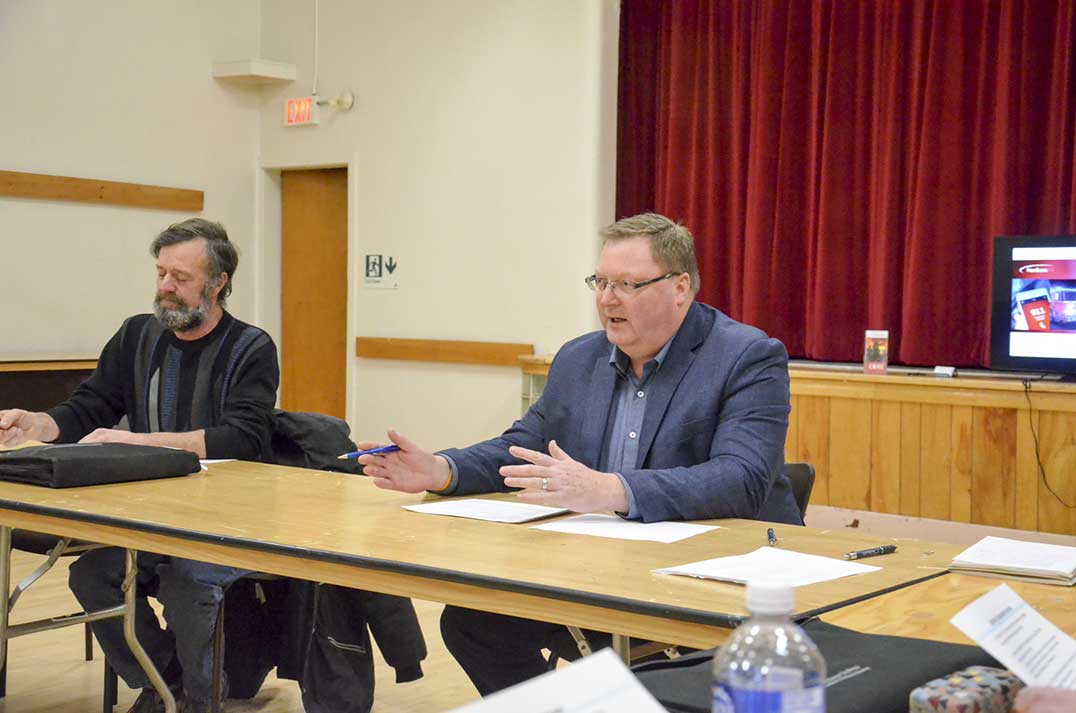Monday to Friday service designed to help residents access Sudbury medical needs, reach other Island communities
MINDEMOYA—One of the biggest challenges facing small rural communities across Northern Ontario, including those on Manitoulin Island, is a severe lack of public transportation with communities. Over the past several decades, the Island has seen what few public transportation links it had steadily wither until they disappeared altogether more than a decade ago; victims of the relentless pressure of rising costs, lower ridership and increased competition in the parcel delivery market. But good news is on the way.
Members of the Manitoulin Municipal Association (MMA) received some welcome public transportation news during its January 17 meeting at the Central Manitoulin Community Centre. Ministry of Northern Development and Mines (MNDM), Ontario Northland Transportation Commission (ONTC) Assistant Deputy Minister Rob Campbell delivered the news that the ONTC would be instituting an intercommunity bus service between Sudbury and Manitoulin Island communities, starting as early as mid-March of this year—and that an expanded service would be operating along the Highway 17 corridor heading east and west of Espanola.

photo by Michael Erskine
The concept behind the service is part of a larger provincial initiative to connect smaller, rural communities that are currently either underserviced or un-serviced to larger urban centres to make it possible for people to access the broader transportation hubs, explained Mr. Campbell. “The focus is on access to education and health services,” noted Mr. Campbell of the drive behind the creation of the new service.
The new service will see bus service between Sudbury and Manitoulin five days a week, although not necessarily all on weekdays. “The plan is to see five-day a week service, one trip a day, each way,” he said.
The proposed Manitoulin Island service route map distributed at the MMA meeting indicates a circuit route that would head out from Sudbury, travel through Nairn Centre and Espanola, through Birch Island into Little Current. Two circuits of the Island would see the bus travelling west through M’Chigeeng, Gore Bay, Spring Bay, Mindemoya, the Slash, Manitowaning, Wiikwemkoong, Sheguiandah back to Little Current, and then following an overnight, travelling the same route in reverse in the morning.
The proposed route presented to the MMA is undergoing a radical reworking as a result of input received from those who met with Mr. Campbell at the table.
“What we had been concentrating on had been connecting the Island to the larger transportation routes,” noted Tracy MacPhee, director of passenger operations at Ontario Northland when contacted following the meeting. “But what came back to us from the meeting was that people were more concerned with getting into and back from Sudbury.” As a result, the initial schedule is undergoing significant revisions.
Another significant change being considered thanks to feedback received at the MMA meeting is the extension of the proposed route further west. Initially, the loops only went as far west as Gore Bay, but thanks to input from Burpee Mills Reeve Ken Noland, who pointed out a significant Amish community was being established further west, some adjustments in that regard are being considered.
The timing and routes for the bus are being designed under the constraints imposed by regulations regarding the amount of time a driver can spend on the road and the physical geography that has to be covered.
“How is this being funded?” asked Northeast Mayor Al MacNevin.
“There will be a fare,” replied Mr. Campbell, “based on a price per kilometre.”
There was some concern expressed that those catching the bus on its round-about circuit might have to pay for the long way around, but Mr. Campbell assured the MMA that the fare would be based on a direct route kilometre. The exact cost of the fares has not yet been announced, but Mr. Campbell said that it would be comparable to those fares currently charged on other ONTC routes.
The bus for the route has already been sourced, a TEMSA TS 30 mini-bus, and the timing for implementation of the route is in part dependant on the vehicle clearing customs and then being assessed and studied by the ONTC maintenance crews.
The TEMSA TS 30 features compact dimensions with “a multitude of comfort features” according to sales sites. Comforts include “an ergonomic driver’s cockpit and luxury interior with a high quality heating and air conditioning system, abundant luggage space, a restroom and reclining seats.” The model slated to serve the Island will also feature WIFI and automated stop announcements.
The ONTC is currently sourcing gas stations and restaurants to act as ticket and bus parcel sales agents and stops. An agent in Espanola has already been brought on board, noted Ms. MacPhee.
Given the widely dispersed populations on Manitoulin Island, the ONTC envisions flag stop (that is the ability to flag the bus down on the side of the road) availability as well. “Of course, they are hoping that people will purchase tickets online ahead of time so that drivers will have some idea of where the riders wish to be picked up.”
The MNDM, the MTO and the ONTC have met with representatives of the United Manitoulin Transit (UMT) group, a committee spearheaded by the March of Dime Canada that has been seeking funding for a feasibility study to implement public transit on Manitoulin Island twice since last December.
“We found the UMT through online searches, which brought up a number of reports in the local press,” noted Mr. Campbell. The first of the meetings was held on December 12 by teleconference, while the second collaborative conversation took place January 4. In those meetings the UMT shared information on its efforts to date in seeking funding for a feasibility study to explore transit solutions for Manitoulin Island.
“I was expecting a little more interaction between the MMA and the assistant deputy minister,” admitted UMT representative Guy Dumas. “They had pretty much the same questions that we did.”
Mr. Dumas said that it is his understanding that the UMT will proceed with seeking to find funding for a feasibility study and expressed some surprise that the ONTC had not conducted such a study before it began its planning. But the ONTC’s expansion of transportation links is based on a matter of public policy and its overall approach is looking at a much broader picture, of which Manitoulin is only one small piece of the puzzle.
The ONTC is a Crown agency, as opposed to a private enterprise, and it is anticipated that the expanded transportation grid will operate at around an 80 percent cost recovery model, explained Mr. Campbell. In a later conversation with The Expositor, Ms. MacPhee pointed out that the cost recovery model is based on a system-wide analysis, not necessarily just the Manitoulin routes in isolation.
“The busier routes, those with heavier traffic, help to subsidize those with fewer passengers,” she said.
Mr. Dumas said that the routes and timing being proposed by the ONTC at the MMA meeting don’t appear to fully meet the needs of those Manitoulin communities represented on the UMT, but he noted that the ONTC and MTO, despite having a template in mind, have indicated that they are “open to reason.”
Mr. Dumas said that he readily agreed with the general sentiment being expressed by MMA representatives as they reacted to the news of the new service was shared, however. “It’s a lot better than what we have now.”
Mr. Campbell also informed the MMA representatives of the Community Transportation Grant Program recently announced by the province.
“Municipalities can apply, now through to February 28, to the $30 million municipal stream of the program through Grants Ontario,” he said. That funding will assist municipalities to develop partnerships and lead projects that build or enhance capacity to better meet local transportation demand and/or deliver long distance intercommunity passenger service that meets people’s needs in areas where there is insufficient service.
Under the Community Transportation Grant Program municipalities can receive up to $500,000 per project for local community transportation service, and up to $1.5 million per project for long distance intercommunity service.
When questioned by Reeve Noland as to whether the unorganized municipalities could access the program now, rather than waiting for the later non-municipal stream, Mr. Campbell suggested that a municipality such as Burpee Mills could partner with the Western Manitoulin unorganized township to put in a partnership application now.
The non-municipal stream will see a $10 million allocation being launched in the summer of 2018 for projects commencing in the fall/winter of 2018. In that stream, Indigenous communities, Indigenous-led organizations and not-for-profits will be able to apply for up to $500,000 per project to deliver local community transportation services outside of the Greater Toronto and Hamilton area.
The broader expansion of intercommunity transit across the North is taking place as a staged process, with changes (such as the expanded bus routes along Highway 17) in December 2017 and continuing through early 2018, with completion of service improvements anticipated by summer 2018. To this end, the ONTC is collaborating with existing licenced private carriers that are currently providing scheduled services in the North. These include Greyhound Bus Lines, which provides scheduled intercommunity bus services along the Trans-Canada (that is Sudbury to Thunder Bay) route and Kasper Transportation Services in northwestern Ontario.
“As service is improved along these routes, the ONTC will monitor ridership and demand to ensure that service levels are meeting passenger needs,” notes a handout provided by Mr. Campbell. “The ONTC remains open to working with willing private carriers and other partners to ensure a safe and efficient intercommunity bus network.”
The Ontario Northland expanded bus service will now service communities west of Espanola, including Sault Ste. Marie, Wawa, White River with stops in Massey, Spanish, Spragge, Blind River and Iron Bridge. This new line began service last week and runs from Sunday to Friday.
Both Mr. Campbell and Ms. MacPhee said they anticipate the new bus routes being in place sometime in mid-March.






